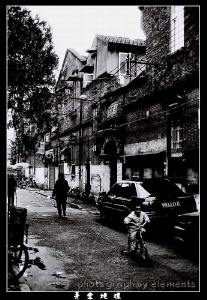Architecture, especially residential architecture, is the mirror of social life. In old Shanghai those who could live in a longtang house could only be people with a fixed income. They had to be able to pay the monthly rent and tax for the house, in this case called the police tax. In the foreign concession, if people failed to pay, they had to move out right away. Since society was divided into different strata, the longtang houses were also classified into high, medium and low ranks. Different ranks of longtang houses were indeed differentiated by quality of construction, but moreover they were differentiated by location. The longtang houses in Zhabei and Nanshi Districts were the lowest in rank, while those in Hongkou District were better, and those located along Bubbling Well Road (now Nanjing Road West) and Avenue Joffre (now Huaihai Road) were the highest. There used to be what is called the "Upper Corner" and the "Lower Corner" of Shanghai. The "Upper" referred to the best location denoted above, and the "Lower" to the lower and lowest location ranks. The house rent in the two "Corners" could differ as much as four to ten times as much. In the early stages, even Chinese commercial buildings, such as banks, shops or import and export firms, managed by traders from Guangdong and Ningbo, took the form of longtang but on a larger scale. They usually had three or five front rooms on both first and second floors with a courtyard in the middle and back rooms behind. The lower floor was used for business, the upper floor for living, the back rooms in the first floor employee dormitories and the courtyard was used as makeshift storage. It was only during the 1930s, when improvements to business systems were made and many new office buildings were built, that this sort of longtang gradually turned into residential use.

The rank differences of longtang could also be reflected in their life-style and culture. "If you enter a longtang, you will find urinals, snack stalls, flies flying in hordes, children fighting in groups, fierce turbulences and sharp curses. What a disorderly small world!" This was what Lu Xun wrote in his essay, "Children in Shanghai" to depict a longtang of the lowest class. Residents of such a longtang , in order to lessen the burden of rent or to earn some extra money, would lot out their surplus rooms to others and became an "er fang dong" (literary a second landlord-a subleaser). Some even divided their houses into many small rooms, or built attics above and had rented them to people who came to Shanghai to make a living or to take refuge. Thus the longtang became very crowded, with bad living conditions and frequent disputes. A satirical play entitled "72 Tenants" gave a vivid description of this sort of longtong. In longtangs of the middle and middle-lower classes, there were also some "er fang dong" and "san fang ke" (those who rented their rooms from the subleaser), but the "fang dong" here would choose their tenants. It is interesting to note that many progressive literary men from interior China at that time lived in the "tingzijian", a small back room in a longtang house, which is cold in the winter and hot in the summer. This evolved the so called "Tingzijian Literature" in the history of modern literature of China. "Tingzijian Literature" is not something that depicted tingzijian, but a term referring to a category of progressive literature written by some young writers who could only afford to live and work in the tough condition of a tingzijian, but that viewed the world with a new and realistic view. People nowadays, when criticizing the indifference of human relationship, like to talk about the good neighborly relationships of past longtangs as a universal model. But, in fact it was only partially true, for it seemed that the higher the class of the longtang, the colder the relationships among residents. In those high-class 1ongtangs, only a few children could be found playing around, and even fewer people passing by. Occasionally, two or three maid servants or cooks could be seen chatting in low voices by one side, or the gate of a house seen opening while a host bids farewell to his guests. Those who were passing by might cast a glance but tried not to pay attention.

